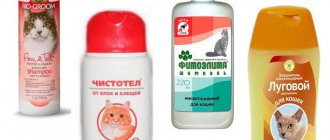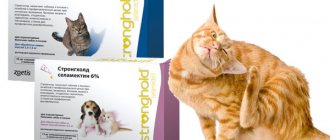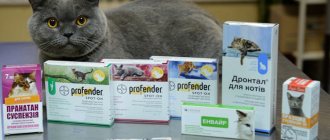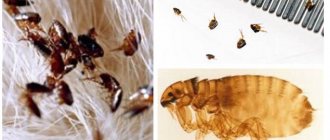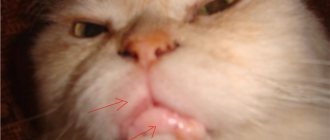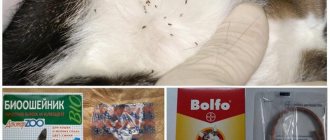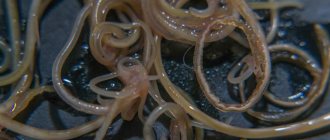Ways of flea infection
The lifespan of a flea is 2 years. She easily tolerates cold and heat and can go without food for 1.5 years. These features allow the flea to survive in extreme conditions and wait for the right moment to get on the cat's body. Infection occurs in several ways:
- While walking. Fleas hide in the grass and under stones. When the animal gets close enough, the flea jumps out of its hiding place and clings to the fur.
- Upon contact with a sick animal. A flea can easily jump from one animal to another.
- In contact with rodents. Fleas can live in the fur of rats, and if a cat catches an infested rodent, it can become infected itself.
- From a human carrier. Flea larvae and eggs stick to clothes and shoes, enter the house, mature and attack pets.
In a private house, the main habitat for fleas is the basement or cellar. They easily get into the house, making their way through cracks, open doors and windows. Therefore, the best protection against infection is preventive measures in the autumn-spring period, when fleas are especially aggressive and active.
Can a domestic cat get fleas?
Cat owners living in apartment buildings do not think about whether a domestic cat can develop fleas . They are confident that their pets are safe. But the routes of infection by parasites are varied. Domestic cats may encounter them:
- At the veterinary clinic. There, in the reception room, there may be an infected animal, and this cannot be foreseen.
- At the entrance. Even if the cat jumps out of the apartment for a short time, this is enough for the fleas to cling to the fur.
- At exhibitions and competitions. A large concentration of animals in one room significantly increases the risk of infection.
- During transportation. Open carriers cannot protect an animal from accidental infection.
Fleas are highly fertile. One insect, falling on a cat’s fur, can lay up to 2000 eggs in it, 10-50 per clutch. The egg ripening period is up to 8 days. Not all eggs from the clutch will be able to hatch, but their number will be enough so that after 2-3 weeks there will be several dozen or even hundreds of adult fleas on the cat’s body.
Preventing fleas in cats
To avoid having to poison your cat's fleas, you can anticipate the danger in advance and carry out preventive procedures. Moreover, the whole process is quite simple and consists primarily of maintaining maximum animal hygiene:
- Select a flea remedy and apply it in the course indicated on the package. Drops are ideal for these purposes - some manufacturers recommend applying them to the cat’s skin once every six months.
- Treat all surfaces in your home to prevent fleas.
- Take your cat to the veterinarian regularly. A specialist can conduct a test that diagnoses the presence of fleas at a stage when they are not yet visible to the naked eye.
- Control who your pet comes in contact with. Do not leave your cat alone on the street - any stray animal is more likely to carry fleas (and other more dangerous parasites).
How to understand that a cat has become infected with fleas: main symptoms
At first, it is difficult to detect fleas on a cat’s body: the insects are very small and easily hide in thick fur. You can notice them if they appear near the ears or eyes, where the hair is short and sparse. The flea looks like a small bug: it has a flat body 2-3 mm long, slightly “compressed” from the sides. Adult insects are black, young ones are brown. There are no mustaches or wings. It is almost impossible to catch a flea with your hands or tweezers: its long hind limbs allow it to jump up to 1.5 meters in height.
To notice an infestation at an early stage, while there are not so many fleas, you need to take a closer look at the cat’s behavior. Infected animal:
- constantly itches, trying to catch the fur with its claws;
- tries to bite a flea by biting the skin while washing;
- refuses food, becomes restless;
- sheds, washes more often than usual.
If fleas cannot be detected, you need to pay attention to the condition of the skin. If there are parasites, there will be redness and insect excrement in the form of large black dust.
The danger of fleas for pets
In addition to the obvious inconveniences that fleas bring to an animal, there are a number of additional dangers:
Flea infestation is especially dangerous for small kittens. Blood-sucking insects cause anemia in them, leading to complete exhaustion and death. It is important to detect a disease in a kitten in time in order to help it. To do this, you should examine not only the animal, but also its sleeping place. To understand where a domestic cat gets fleas , it’s a good idea to look under the carpeting, behind sofas and other upholstered furniture. Fleas are dangerous because they are excellent at hiding and waiting for the right moment to attack.
The danger of cat fleas to humans
Are cat fleas transmitted to humans? This question interests all owners of “fluffy dogs”. Despite the fact that fleas are not able to live on the human body (due to the lack of fur), they can cause significant damage to the health, even the life of the pet owner. Jumping insects easily jump onto a person.
Direct contact with an infected animal is not necessary. Infection occurs through any surface where the cat played, lay, or even passed by. It is in these places that fleas wait for a new victim. After all, pests do not live on cats; after a meal, they immediately jump off, then jump on again if they are hungry.
Are cat fleas dangerous for humans? Certainly! The main danger lies not only in the bites themselves, the unpleasantness of the situation, but also in the ability of fleas to carry dangerous diseases:
- rashes on the skin are the body’s reaction to a flea bite;
- as a result, massive dermatitis (inflammation of the skin) is formed;
- if insects get into food, their further consumption can lead to serious food poisoning;
- fleas are carriers of brucellosis, infection with the disease threatens damage to internal organs, fever, and further death of the patient;
- creeping erythema. A person suffers from constantly emerging dead ulcers, the skin peels, the skin turns pale;
- Many people have a severe allergic reaction to flea bites. The pathological condition manifests itself as an increase in temperature, difficulty breathing, up to anaphylactic shock;
- Anthrax infection is very dangerous for human life. A person experiences hematomas, internal organs are severely affected, erosions appear, which leads to general intoxication of the body and death.
Considering the consequences of cat flea bites described above, it is impossible to postpone the destruction of parasites in your pet. Being close to an infected animal promises not only health problems, but also death.
How to recognize and what bites look like
The flea pierces human skin, but does not release anesthetic substances. Due to this, the victim immediately feels the flea attack (similar to a needle prick). After saturation, the insect detaches from the wound, the blood does not come out, but remains inside, forming hematomas.
After a bite, a slight halo of redness is observed on a person’s skin; enzymes in the insect’s saliva cause an allergic reaction. The bite site begins to itch very much, a blister appears, rashes near the puncture site, and swelling.
Note! Bites are often localized in the leg area (the blisters are often located a couple of centimeters from each other). But different parts of the body can be negatively affected, because flea infestations can occur at night, when the victim is sleeping and cannot resist.
Treatment and prevention of fleas
Fleas reproduce very quickly, and treatment should begin as soon as the parasites are detected. For this purpose, various chemical and folk remedies are used.
Treatment with chemicals
The main drugs that veterinarians recommend to use to control fleas can be divided into groups:
It is most convenient to use concentrated solutions in ampoules. To apply the medicine to the skin, you need to open the ampoule and carefully pour the contents onto the withers: the area between the shoulder blades. It is imperative to use gloves and wash your hands after the procedure. The solution applied to the skin is safe for people and animals, but if it gets on mucous membranes it can cause a burn. Within a day after application, most adult fleas will die. To consolidate the result, the procedure can be repeated after 2 weeks.
The most popular preparations containing insecticides:
Anti-flea shampoos have also proven themselves to be effective. They will have to be used longer - the concentration of the insecticide in the shampoo is weaker. To completely kill fleas, 5-6 procedures will be required.
After treatment, it is important to follow preventive measures. There is a high probability that there are flea eggs left in the apartment, and the animal may become infected again. To prevent this, you need to regularly carry out wet cleaning by adding eucalyptus or wormwood essential oil to the water.
A collar will help protect the animal. It is completely safe for cats and can contain both natural and synthetic insecticides. You can even let your cat go outside while wearing a collar – the drug will repel fleas. And if they do get on the fur, within a few hours the insecticide will paralyze them.
Treatment with traditional methods
Before the invention of safe, effective drugs for treating cats against fleas, folk remedies were used. Herbs with a disinfectant effect and a strong pungent odor are suitable for this: wormwood, garlic, eucalyptus. You need to prepare a decoction of the herbs and add it to the bath. For 1 l. broth you need 3 tbsp. spoons of dry or fresh plant. After pouring boiling water over the herb, let the broth sit for 15-20 minutes, strain and dilute with water. Instead of herbal infusion, you can use tar soap.
You can also make a bath with salt and soda. After mixing them in equal proportions, pour in warm water and wait until the mixture dissolves. Simply spraying the cat with the mixture is not enough - fleas hide in the undercoat and water flowing down the fur will not reach them. The broth should be rubbed into the wool, soaking it. The procedure will take a lot of time and you need to monitor the water temperature so that the animal does not freeze or catch a cold. The cat's sleeping place also needs to be treated: sprinkle with a decoction of wormwood or put a bag of dry grass.
If the animal is categorically against baths, the only option from the arsenal of folk remedies is combing with a fine comb. It is not possible to completely get rid of fleas, but regular combing will reduce their number.
Treatment
There are various ways to get rid of fleas.
When choosing one or another remedy, folk or purchased, you need to consider:
Sarcoptic mange
Is it possible to give deworming medication to a pregnant cat?
Giardiasis
- Breed of the animal.
- Health status.
- Age (some products have age restrictions).
- Availability of other pets.
- Risk of allergies.
Let's look at the main types of flea control agents.
Drops
In terms of popularity, drops on the withers are inferior to shampoos and collars, but in terms of effectiveness they have proven themselves well.
Advantages of drops:
- Can be used for animals afraid of water.
- Convenient to use for pets that cannot be forced to swallow a tablet.
Apply drops to dry, clean skin, on the animal’s withers. The pipette is opened immediately before use and then discarded.
Here is a mini-review of the most common means:
- "Advocate" . Colorless liquid in a pipette. The active substance has a detrimental effect on the nervous system of parasites, which contributes to their rapid extinction. Helps get rid of fleas and worms. Not recommended for use in kittens under one year of age.
- "Stronghold" . The drug is from Pfizer (USA). The dosage is selected depending on the pet’s body weight. The active substance, absorbed into the skin, protects against fleas for a long time.
- "Inspector" . A universal drug that successfully fights parasites such as worms, ticks and fleas. Can be used for kittens from 1.5 months of age.
- "Weaphar" Natural product from Dutch manufacturers. The advantage of the medicine is that it destroys even the larvae of bloodsuckers. Has no side effects. Cannot be used on kittens.
When choosing drops, you need to consider the following factors:
- Range of actions: universal or narrowly targeted drug.
- Duration of action.
- Destruction of fleas and their larvae.
- Degree of toxicity.
Collars
A collar is the simplest means of fighting fleas. They are coated with repellents that are harmful to insects on the animal’s body. In addition, collars are also used for preventive purposes.
The collar is equipped with a fastener for fastening it on the animal’s neck. The insecticide is not washed off with water. The accessory itself is made of waterproof material. The duration of action is several months.
Advantages:
- Easy to use.
- Ideal for cats who don't like to swim.
- Availability of special modifications for babies and pregnant cats.
- Versatility (the collar helps fight fleas and ticks).
- Long validity period: from 1 to 5 months.
There are also disadvantages:
- Risk of injury if cat gets caught.
- Reduced service life when heavily wet.
- The effectiveness of the product depends on the conditions under which the animal is kept, the individual characteristics of the pet, and its state of health.
The most common brands: Bars, Hartz, Bolfo. Before purchasing a collar, you should consult a veterinarian, since accessories from different brands have contraindications.
Sprays
Spray is an immediate action product. After the product is applied to the fur, the blood-sucking insects die immediately. However, care must be taken not to harm the cat. When processing an animal, a special collar is put on it so that the pet cannot lick itself. After a certain time, according to the instructions, the spray is washed off with water.
The most popular sprays:
- Produced in 100 ml bottles. 1 bottle is enough for 2 years of use. Duration of action – 40 days. Apply spray against fur.
- Safe hypoallergenic drug. There is a special modification for kittens.
Shampoos
This is the most popular remedy among owners. The shampoo is inexpensive, has no contraindications, and smells nice.
There are 2 types of shampoos:
- Preventive . The extracts contained in them repel parasites.
- Medicinal . This product contains chemical ingredients and insecticides that kill ticks and fleas. Such shampoos are not intended for long-term use, as they dry out the skin and worsen the appearance of the coat.
Before purchasing shampoo, pay attention to the following points:
- Purpose of the drug, its composition.
- Degree of toxicity.
- Age restrictions.
- Features of the animal's fur.
When using shampoos, just washing your pet is not enough. Treat animal bedding and toys. Otherwise, re-infection is inevitable.
The most popular shampoos:
- Bars . Budget-friendly preventative with lavender, pelargonium and cloves. Intended for single use. Has a repellent effect. The only contraindication is individual intolerance to the components. Can be used for small kittens.
- Celandine . The main active substance is the insecticide Permitrin. In addition, the shampoo contains aloe extract, castor oil, vitamin E. Cannot be used for kittens and pregnant cats.
- MS.KISS . Anti-flea shampoo for adult cats of long-haired breeds. The bottle is equipped with a dispenser. The shampoo contains a conditioner that makes it easier to comb the coat after bathing.
Pills
Using special tablets is the most effective and safe way to combat blood-sucking insects. The medicine is absorbed into the gastrointestinal tract and enters the blood. After a flea bites a cat, it receives a dose of insecticide and then dies. It is recommended to use the tablets together with sprays and anti-flea shampoos.
Comfortis
A common tablet drug among transporters is Comfortis . The active substance is safe for cats, but certainly kills parasites. Beef is added to the tablets, so your pet eats them with pleasure.
The tablets are convenient to mix into cat food. The dosage is set at the rate of 50 mg of the drug per kilogram of animal body weight. The duration of action of the tablets is one month. Can be used for cats with skin defects.
Comfortis is not recommended for use in pregnant cats, small kittens, or older animals.
Capstar
This drug has proven itself well. Its time on the market exceeds 10 years. The medicine belongs to the category of neurotoxins, so the blood-sucking parasites die out quickly. The activation of the drug begins 2.5-3 hours after administration. Valid for 1, 2 days. Can be used for babies from one month of age. The product does not have side effects.
Injections
Injections are an effective anti-flea treatment for cats. However, this option also has a drawback.
Not every owner can give an injection on their own. In addition, the cat is resisting. And a trip to the veterinarian is an additional time investment. Therefore, the injection method cannot be called widespread. However, it is effective. An injection of a special drug helps the animal avoid infection even when in contact with a cat infected with fleas.
Another disadvantage of injections is that they are contraindicated for small kittens and pregnant cats.
The most common anti-flea injections are:
- Ivermectin . The injections are given twice, with a ten-day break. Good for fleas and ticks.
- Eprimek . Helps to recover from diseases caused by parasites: worms and fleas. The dosage is 0.1 ml per 5 kg of animal weight. Intramuscular injections.
- Lufenuron . A gentle product aimed at preventing fleas from laying eggs. Lufenuron is used in combination with collars and special shampoos.
When choosing one or another option for killing fleas, take into account the characteristics of each animal. Anti-flea collars are suitable for some, shampoo is suitable for others, and several different drugs have to be used at once for others. The health status of the animal should also be taken into account.
